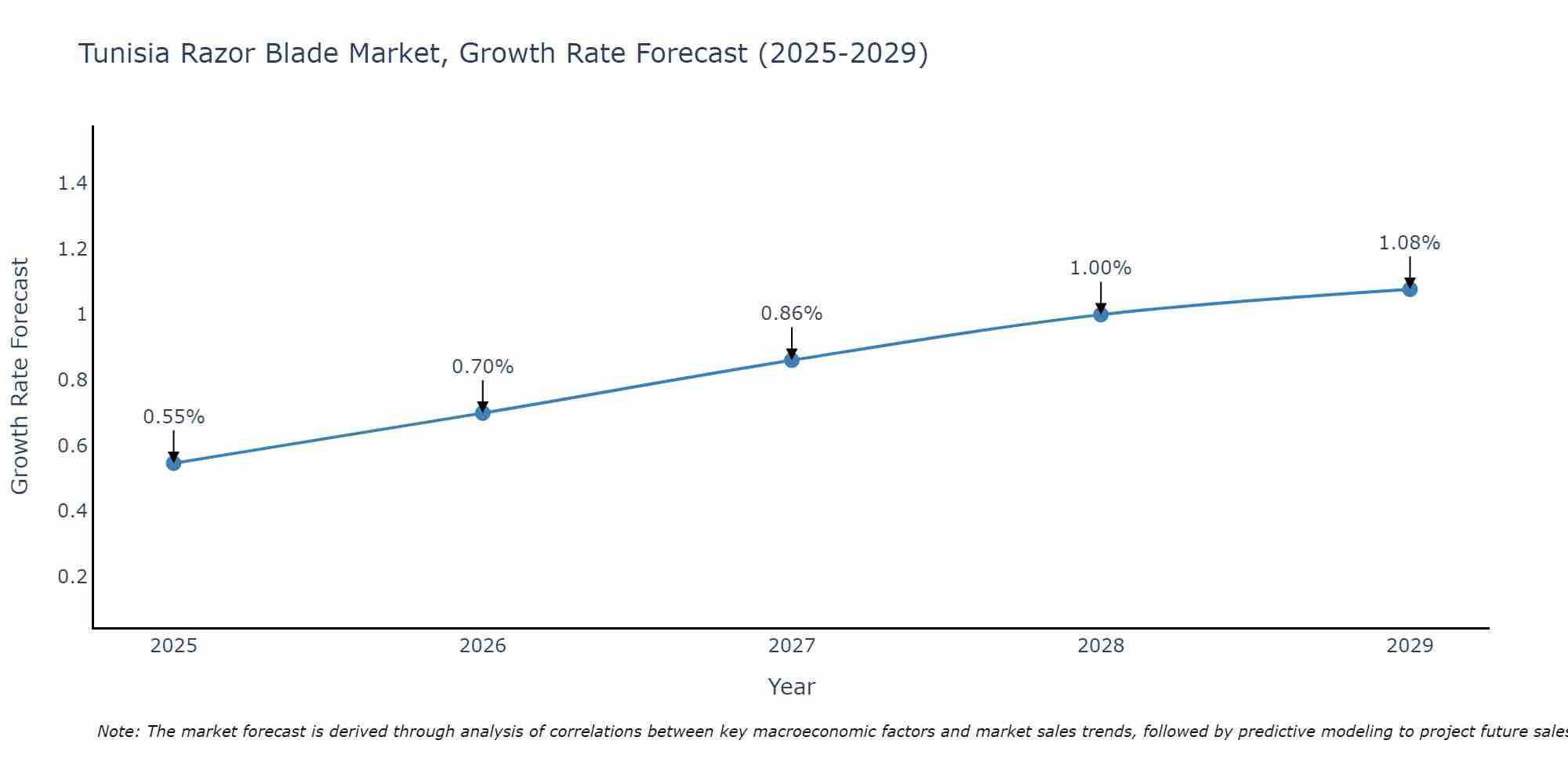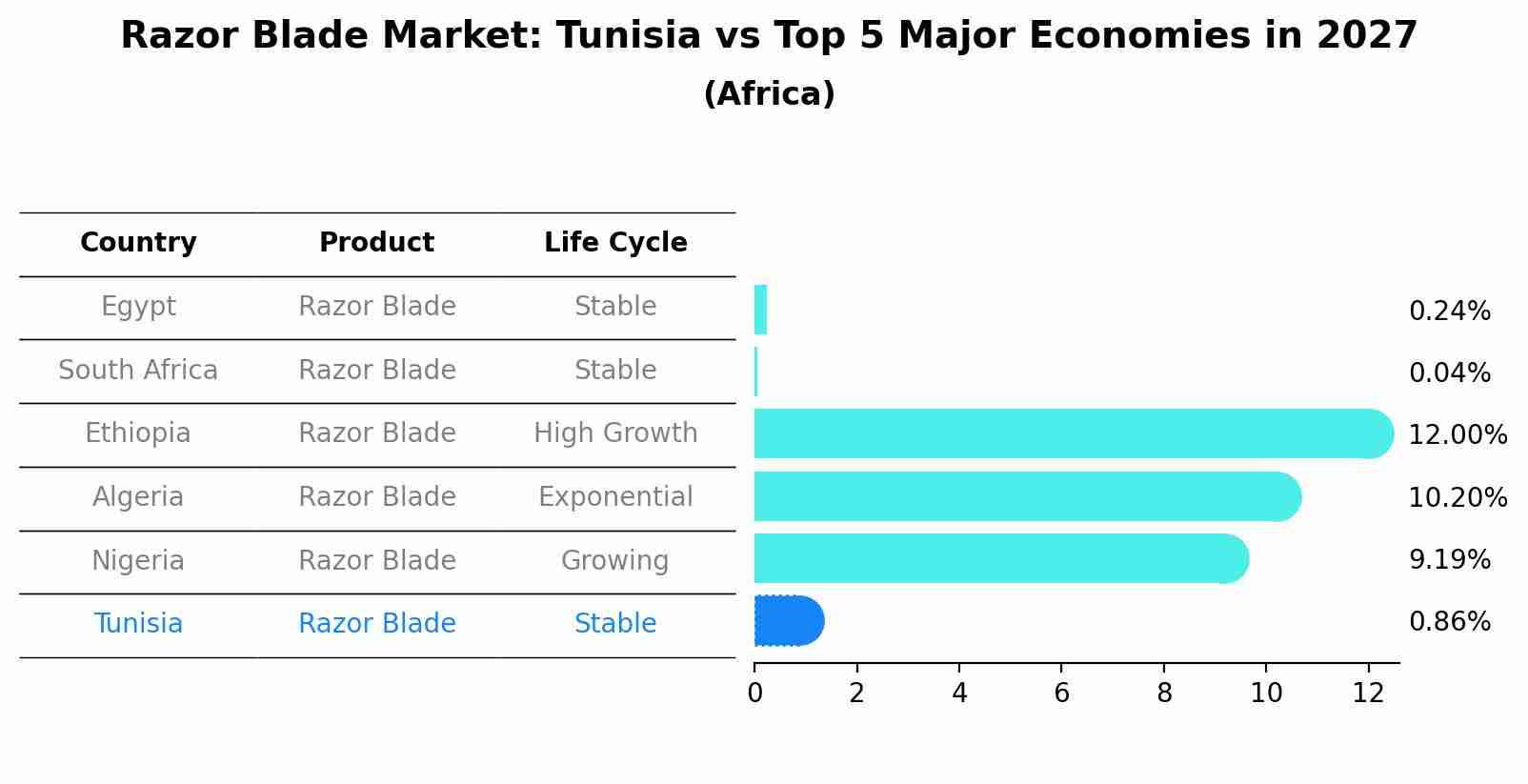Tunisia Razor Blade Market (2025-2031) Outlook | Analysis, Industry, Companies, Value, Forecast, Growth, Trends, Share, Revenue & Size
| Product Code: ETC302994 | Publication Date: Aug 2022 | Updated Date: Aug 2025 | Product Type: Market Research Report | |
| Publisher: 6Wresearch | Author: Shubham Padhi | No. of Pages: 75 | No. of Figures: 35 | No. of Tables: 20 |
Tunisia Razor Blade Market Size Growth Rate
The Tunisia Razor Blade Market is likely to experience consistent growth rate gains over the period 2025 to 2029. From 0.55% in 2025, the growth rate steadily ascends to 1.08% in 2029.

Razor Blade Market: Tunisia vs Top 5 Major Economies in 2027 (Africa)
Tunisia's Razor Blade market is anticipated to experience a stable growth rate of 0.86% by 2027, reflecting trends observed in the largest economy Egypt, followed by South Africa, Ethiopia, Algeria and Nigeria.

Tunisia Razor Blade Market Overview
The razor blade market in Tunisia is driven by the demand for personal grooming products. While there is steady demand, the market faces challenges such as competition from electric shavers and low-cost imports. To stay competitive, local manufacturers are focusing on product innovation, such as introducing blades with improved sharpness and durability, and enhancing their marketing strategies to attract a broader consumer base.
Drivers of the market
The Tunisia razor blade market is driven by factors such as increasing disposable income and rising grooming awareness among the population. The growing trend of personal grooming and the influence of social media on beauty standards contribute to higher demand for razor blades. Additionally, innovations in razor blade technology and the availability of a wide range of products catering to different needs boost market growth.
Challenges of the market
The Tunisia Razor Blade Market faces challenges including intense competition from both international and local brands, price sensitivity among consumers, and the threat of counterfeit products. Technological advancements in shaving products and changing grooming habits also pose significant hurdles.
Government Policy of the market
The Tunisian government has implemented policies to support local manufacturing industries, including the production of razor blades. These policies include tax incentives, import tariff adjustments on raw materials, and subsidies for technological upgrades. The government also encourages foreign direct investment in the sector to enhance production capabilities and meet both domestic and export demands.
Key Highlights of the Report:
- Tunisia Razor Blade Market Outlook
- Market Size of Tunisia Razor Blade Market, 2024
- Forecast of Tunisia Razor Blade Market, 2031
- Historical Data and Forecast of Tunisia Razor Blade Revenues & Volume for the Period 2021-2031
- Tunisia Razor Blade Market Trend Evolution
- Tunisia Razor Blade Market Drivers and Challenges
- Tunisia Razor Blade Price Trends
- Tunisia Razor Blade Porter's Five Forces
- Tunisia Razor Blade Industry Life Cycle
- Historical Data and Forecast of Tunisia Razor Blade Market Revenues & Volume By Type for the Period 2021-2031
- Historical Data and Forecast of Tunisia Razor Blade Market Revenues & Volume By Single Edge for the Period 2021-2031
- Historical Data and Forecast of Tunisia Razor Blade Market Revenues & Volume By Double Edge for the Period 2021-2031
- Historical Data and Forecast of Tunisia Razor Blade Market Revenues & Volume By Blade Material for the Period 2021-2031
- Historical Data and Forecast of Tunisia Razor Blade Market Revenues & Volume By Carbon Steel for the Period 2021-2031
- Historical Data and Forecast of Tunisia Razor Blade Market Revenues & Volume By Stainless Steel for the Period 2021-2031
- Historical Data and Forecast of Tunisia Razor Blade Market Revenues & Volume By End User for the Period 2021-2031
- Historical Data and Forecast of Tunisia Razor Blade Market Revenues & Volume By Men for the Period 2021-2031
- Historical Data and Forecast of Tunisia Razor Blade Market Revenues & Volume By Women for the Period 2021-2031
- Historical Data and Forecast of Tunisia Razor Blade Market Revenues & Volume By Distribution Channel for the Period 2021-2031
- Historical Data and Forecast of Tunisia Razor Blade Market Revenues & Volume By Supermarkets/Hypermarkets for the Period 2021-2031
- Historical Data and Forecast of Tunisia Razor Blade Market Revenues & Volume By Departmental Stores for the Period 2021-2031
- Historical Data and Forecast of Tunisia Razor Blade Market Revenues & Volume By Convenience Stores for the Period 2021-2031
- Historical Data and Forecast of Tunisia Razor Blade Market Revenues & Volume By Online for the Period 2021-2031
- Tunisia Razor Blade Import Export Trade Statistics
- Market Opportunity Assessment By Type
- Market Opportunity Assessment By Blade Material
- Market Opportunity Assessment By End User
- Market Opportunity Assessment By Distribution Channel
- Tunisia Razor Blade Top Companies Market Share
- Tunisia Razor Blade Competitive Benchmarking By Technical and Operational Parameters
- Tunisia Razor Blade Company Profiles
- Tunisia Razor Blade Key Strategic Recommendations
Frequently Asked Questions About the Market Study (FAQs):
1 Executive Summary |
2 Introduction |
2.1 Key Highlights of the Report |
2.2 Report Description |
2.3 Market Scope & Segmentation |
2.4 Research Methodology |
2.5 Assumptions |
3 Tunisia Razor Blade Market Overview |
3.1 Tunisia Country Macro Economic Indicators |
3.2 Tunisia Razor Blade Market Revenues & Volume, 2021 & 2031F |
3.3 Tunisia Razor Blade Market - Industry Life Cycle |
3.4 Tunisia Razor Blade Market - Porter's Five Forces |
3.5 Tunisia Razor Blade Market Revenues & Volume Share, By Type, 2021 & 2031F |
3.6 Tunisia Razor Blade Market Revenues & Volume Share, By Blade Material, 2021 & 2031F |
3.7 Tunisia Razor Blade Market Revenues & Volume Share, By End User, 2021 & 2031F |
3.8 Tunisia Razor Blade Market Revenues & Volume Share, By Distribution Channel, 2021 & 2031F |
4 Tunisia Razor Blade Market Dynamics |
4.1 Impact Analysis |
4.2 Market Drivers |
4.2.1 Increasing disposable income in Tunisia leading to higher purchasing power for personal grooming products. |
4.2.2 Growing urban population with a preference for grooming and personal care products. |
4.2.3 Changing lifestyle trends towards grooming and self-care routines. |
4.3 Market Restraints |
4.3.1 Intense competition from local and international razor blade manufacturers. |
4.3.2 Price sensitivity among consumers due to economic fluctuations. |
4.3.3 Availability of alternative grooming methods like electric shavers impacting razor blade sales. |
5 Tunisia Razor Blade Market Trends |
6 Tunisia Razor Blade Market, By Types |
6.1 Tunisia Razor Blade Market, By Type |
6.1.1 Overview and Analysis |
6.1.2 Tunisia Razor Blade Market Revenues & Volume, By Type, 2021-2031F |
6.1.3 Tunisia Razor Blade Market Revenues & Volume, By Single Edge, 2021-2031F |
6.1.4 Tunisia Razor Blade Market Revenues & Volume, By Double Edge, 2021-2031F |
6.2 Tunisia Razor Blade Market, By Blade Material |
6.2.1 Overview and Analysis |
6.2.2 Tunisia Razor Blade Market Revenues & Volume, By Carbon Steel, 2021-2031F |
6.2.3 Tunisia Razor Blade Market Revenues & Volume, By Stainless Steel, 2021-2031F |
6.3 Tunisia Razor Blade Market, By End User |
6.3.1 Overview and Analysis |
6.3.2 Tunisia Razor Blade Market Revenues & Volume, By Men, 2021-2031F |
6.3.3 Tunisia Razor Blade Market Revenues & Volume, By Women, 2021-2031F |
6.4 Tunisia Razor Blade Market, By Distribution Channel |
6.4.1 Overview and Analysis |
6.4.2 Tunisia Razor Blade Market Revenues & Volume, By Supermarkets/Hypermarkets, 2021-2031F |
6.4.3 Tunisia Razor Blade Market Revenues & Volume, By Departmental Stores, 2021-2031F |
6.4.4 Tunisia Razor Blade Market Revenues & Volume, By Convenience Stores, 2021-2031F |
6.4.5 Tunisia Razor Blade Market Revenues & Volume, By Online, 2021-2031F |
7 Tunisia Razor Blade Market Import-Export Trade Statistics |
7.1 Tunisia Razor Blade Market Export to Major Countries |
7.2 Tunisia Razor Blade Market Imports from Major Countries |
8 Tunisia Razor Blade Market Key Performance Indicators |
8.1 Average revenue per user (ARPU) for razor blade products in Tunisia. |
8.2 Market penetration rate of razor blade products among the target demographic. |
8.3 Customer satisfaction and retention rates for razor blade brands in Tunisia. |
8.4 Innovation and new product development pipeline for razor blade products. |
8.5 Brand awareness and perception metrics among Tunisian consumers. |
9 Tunisia Razor Blade Market - Opportunity Assessment |
9.1 Tunisia Razor Blade Market Opportunity Assessment, By Type, 2021 & 2031F |
9.2 Tunisia Razor Blade Market Opportunity Assessment, By Blade Material, 2021 & 2031F |
9.3 Tunisia Razor Blade Market Opportunity Assessment, By End User, 2021 & 2031F |
9.4 Tunisia Razor Blade Market Opportunity Assessment, By Distribution Channel, 2021 & 2031F |
10 Tunisia Razor Blade Market - Competitive Landscape |
10.1 Tunisia Razor Blade Market Revenue Share, By Companies, 2024 |
10.2 Tunisia Razor Blade Market Competitive Benchmarking, By Operating and Technical Parameters |
11 Company Profiles |
12 Recommendations |
13 Disclaimer |
- Single User License$ 1,995
- Department License$ 2,400
- Site License$ 3,120
- Global License$ 3,795
Search
Related Reports
- ASEAN Bearings Market (2025-2031) | Strategy, Consumer Insights, Analysis, Investment Trends, Opportunities, Growth, Size, Share, Industry, Revenue, Segments, Value, Segmentation, Supply, Forecast, Restraints, Outlook, Competition, Drivers, Trends, Demand, Pricing Analysis, Competitive, Strategic Insights, Companies, Challenges
- Europe Flooring Market (2025-2031) | Outlook, Share, Industry, Trends, Forecast, Companies, Revenue, Size, Analysis, Growth & Value
- Saudi Arabia Manlift Market (2025-2031) | Outlook, Size, Growth, Trends, Companies, Industry, Revenue, Value, Share, Forecast & Analysis
- Uganda Excavator, Crane, and Wheel Loaders Market (2025-2031) | Strategy, Consumer Insights, Analysis, Investment Trends, Opportunities, Growth, Size, Share, Industry, Revenue, Segments, Value, Segmentation, Supply, Forecast, Restraints, Outlook, Competition, Drivers, Trends, Demand, Pricing Analysis, Competitive, Strategic Insights, Companies, Challenges
- Rwanda Excavator, Crane, and Wheel Loaders Market (2025-2031) | Strategy, Consumer Insights, Analysis, Investment Trends, Opportunities, Growth, Size, Share, Industry, Revenue, Segments, Value, Segmentation, Supply, Forecast, Restraints, Outlook, Competition, Drivers, Trends, Demand, Pricing Analysis, Competitive, Strategic Insights, Companies, Challenges
- Kenya Excavator, Crane, and Wheel Loaders Market (2025-2031) | Strategy, Consumer Insights, Analysis, Investment Trends, Opportunities, Growth, Size, Share, Industry, Revenue, Segments, Value, Segmentation, Supply, Forecast, Restraints, Outlook, Competition, Drivers, Trends, Demand, Pricing Analysis, Competitive, Strategic Insights, Companies, Challenges
- Angola Excavator, Crane, and Wheel Loaders Market (2025-2031) | Strategy, Consumer Insights, Analysis, Investment Trends, Opportunities, Growth, Size, Share, Industry, Revenue, Segments, Value, Segmentation, Supply, Forecast, Restraints, Outlook, Competition, Drivers, Trends, Demand, Pricing Analysis, Competitive, Strategic Insights, Companies, Challenges
- Israel Intelligent Transport System Market (2025-2031) | Strategy, Consumer Insights, Analysis, Investment Trends, Opportunities, Growth, Size, Share, Industry, Revenue, Segments, Value, Segmentation, Supply, Forecast, Restraints, Outlook, Competition, Drivers, Trends, Demand, Pricing Analysis, Competitive, Strategic Insights, Companies, Challenges
- Uganda Precast and Aggregate Market (2025-2031) | Strategy, Consumer Insights, Analysis, Investment Trends, Opportunities, Growth, Size, Share, Industry, Revenue, Segments, Value, Segmentation, Supply, Forecast, Restraints, Outlook, Competition, Drivers, Trends, Demand, Pricing Analysis, Competitive, Strategic Insights, Companies, Challenges
- Australia IT Asset Disposal Market (2025-2031) | Strategy, Consumer Insights, Analysis, Investment Trends, Opportunities, Growth, Size, Share, Industry, Revenue, Segments, Value, Segmentation, Supply, Forecast, Restraints, Outlook, Competition, Drivers, Trends, Demand, Pricing Analysis, Competitive, Strategic Insights, Companies, Challenges
Industry Events and Analyst Meet
Our Clients
Whitepaper
- Middle East & Africa Commercial Security Market Click here to view more.
- Middle East & Africa Fire Safety Systems & Equipment Market Click here to view more.
- GCC Drone Market Click here to view more.
- Middle East Lighting Fixture Market Click here to view more.
- GCC Physical & Perimeter Security Market Click here to view more.
6WResearch In News
- Doha a strategic location for EV manufacturing hub: IPA Qatar
- Demand for luxury TVs surging in the GCC, says Samsung
- Empowering Growth: The Thriving Journey of Bangladesh’s Cable Industry
- Demand for luxury TVs surging in the GCC, says Samsung
- Video call with a traditional healer? Once unthinkable, it’s now common in South Africa
- Intelligent Buildings To Smooth GCC’s Path To Net Zero













